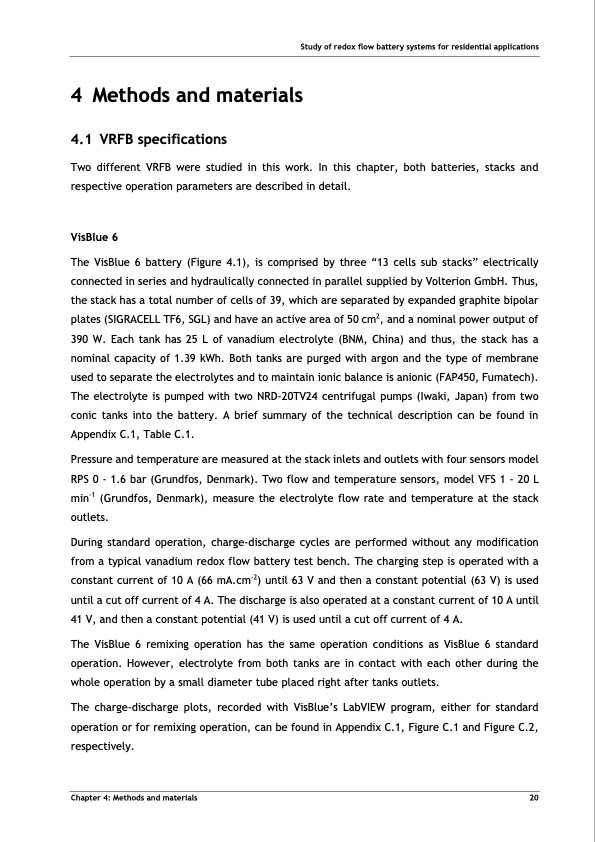
PDF Publication Title:
Text from PDF Page: 031
Study of redox flow battery systems for residential applications 4 Methods and materials 4.1 VRFB specifications Two different VRFB were studied in this work. In this chapter, both batteries, stacks and respective operation parameters are described in detail. VisBlue 6 The VisBlue 6 battery (Figure 4.1), is comprised by three “13 cells sub stacks” electrically connected in series and hydraulically connected in parallel supplied by Volterion GmbH. Thus, the stack has a total number of cells of 39, which are separated by expanded graphite bipolar plates (SIGRACELL TF6, SGL) and have an active area of 50 cm2, and a nominal power output of 390 W. Each tank has 25 L of vanadium electrolyte (BNM, China) and thus, the stack has a nominal capacity of 1.39 kWh. Both tanks are purged with argon and the type of membrane used to separate the electrolytes and to maintain ionic balance is anionic (FAP450, Fumatech). The electrolyte is pumped with two NRD-20TV24 centrifugal pumps (Iwaki, Japan) from two conic tanks into the battery. A brief summary of the technical description can be found in Appendix C.1, Table C.1. Pressure and temperature are measured at the stack inlets and outlets with four sensors model RPS 0 - 1.6 bar (Grundfos, Denmark). Two flow and temperature sensors, model VFS 1 - 20 L min-1 (Grundfos, Denmark), measure the electrolyte flow rate and temperature at the stack outlets. During standard operation, charge-discharge cycles are performed without any modification from a typical vanadium redox flow battery test bench. The charging step is operated with a constant current of 10 A (66 mA.cm-2) until 63 V and then a constant potential (63 V) is used until a cut off current of 4 A. The discharge is also operated at a constant current of 10 A until 41 V, and then a constant potential (41 V) is used until a cut off current of 4 A. The VisBlue 6 remixing operation has the same operation conditions as VisBlue 6 standard operation. However, electrolyte from both tanks are in contact with each other during the whole operation by a small diameter tube placed right after tanks outlets. The charge-discharge plots, recorded with VisBlue’s LabVIEW program, either for standard operation or for remixing operation, can be found in Appendix C.1, Figure C.1 and Figure C.2, respectively. Chapter 4: Methods and materials 20PDF Image | Tubular Vanadium Air Redox‐flow battery

PDF Search Title:
Tubular Vanadium Air Redox‐flow batteryOriginal File Name Searched:
204521.pdfDIY PDF Search: Google It | Yahoo | Bing
Salgenx Redox Flow Battery Technology: Salt water flow battery technology with low cost and great energy density that can be used for power storage and thermal storage. Let us de-risk your production using our license. Our aqueous flow battery is less cost than Tesla Megapack and available faster. Redox flow battery. No membrane needed like with Vanadium, or Bromine. Salgenx flow battery
| CONTACT TEL: 608-238-6001 Email: greg@salgenx.com | RSS | AMP |